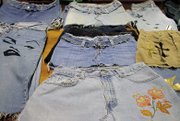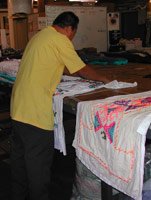New Looks With a Vintage Twist
SuperLuckyCat Inc. never underestimates the value of sorting.
Three of the Los Angeles company’s seven workers are sorters. The job is vital because SuperLuckyCat uses vintage garments instead of conventional fabric as the foundation for its clothes. In the same amount of time it might take another apparel manufacturer to cut, sew and inspect a T-shirt, a SuperLuckyCat employee measures the dimensions of a Mexican peasant dress. The sorter must ensure that the dress has no holes or stains and that it offers enough fabric to be reworked into a long embroidered skirt that will wholesale for $38 as part of the company’s Summer 2005 collection.
SuperLuckyCat sorts and cuts by hand because the materials are not the same size, explained Michael Baffico, who runs the company with Crystal Butler, his girlfriend and the designer. Butler said they have tried to model SuperLuckyCat after a traditional manufacturer, employing a patternmaker and production manager. Yet, if they started with fabric instead of vintage clothing, their labor costs would be at least 50 percent lower.
SuperLuckyCat is not alone. Sterling Williams said he spent 90 minutes tweaking a black Polo by Ralph Lauren blazer with pink paint smears and an appliqueacute; declaring “Lifes [sic] too short to blend in” for Los Angeles–based Sterling Wear. The labor contributed to the wholesale price of $150. Williams said he sold other blazers to boutiques such as The Cosmo Shop, located on Los Angeles’ Melrose Avenue.
Cosmo Shop’s owner, Cosmo Lombino, has been reworking vintage garments into knickers, blazers, tutus and other items for some 14 years. “I’m the queen of tricking stuff out,” he said.
Though some customers love the reworked vintage, others need to be educated. “Sometimes you got to say it is a vintage item but it is redone,” he said. “They buy it more so because it is eclectic and vintage.”
Capitalizing on the vintage buzz
The popularity of reworked vintage is growing as consumers clamor for one-of-a-kind items, and vintage is the buzzword in the industry. Designers such as Lombino, Williams and Los Angeles–based Meghan Fabulous have built their businesses on tricking out vintage. But to make it on as large a scale as SuperLuckyCat is a challenge. It certainly takes more time and effort to fashion a new design out of an older garment than from a bolt of fabric. Inevitably, vintage’s popularity is leading to its scarcity.
The difficulty in finding and reworking vintage clothes led Derek Banton to modify his 5-year-old label, Riley, which is part of Born Again Clothing Inc. in Vernon, Calif. Founded in 1987 as a provider of vintage clothing to global apparel companies, Born Again Clothing used to buy garments by the baleful, Banton said. But the Born Again Clothing chief executive said these days one has to hand-pick through the piles. “It’s way harder,” Banton said. Riley has produced skirts, jackets and other apparel items that are made completely from vintage garments or embellished with vintage lace and trimmings. Banton said he suspended Riley’s shipments for the past couple of months because he is in the middle of changing the business. He declined to elaborate on the new form the label will take.
Angel Fez said he has been busy tracking down vintage items that sell from $60 to $2,000 apiece for companies that use the garments in design and product development. Fez, the founder of Vintage Clothing Procurer, said he plans to open a site for his company in the California Market Center in downtown Los Angeles as early as July. “It’s very hard to find information on vintage,” Fez said, adding that demand is “not going to stop.”
Custom creations
Joe Bush, the owner and designer of Joe Bush Jeans in Torrance, Calif., also faces the prospect of limited raw materials. A former stockbroker, Bush exported vintage Levi’s to Europe and Japan in the 1990s, shipping as many as 20,000 pairs a month. With the strengthening of the dollar at the millennium’s turn, the export business became too costly. “I had 35,000 jeans to look at, and my market was diminishing,” Bush recalled.
In 2003, he said he met with Sharon Segal and got the idea to tie-dye the Levi’s. Bush now transforms Levi’s into gauchos, Daisy Duke shorts, and mini- and maxi-skirts that are enhanced with embroidery, leatherwork and stenciling. He said his monthly shipments have surged to 3,000 to 4,000 pieces from “a couple hundred” in 2003. His retail accounts number approximately 100 in the United States, Europe and Japan, including Belle Gray in Los Angeles; Indigo in Santa Monica, Calif.; and Madison in Los Angeles and Malibu, Calif.
Success came with a price. “People like me sent so many [vintage Levi’s] overseas during the ’90s, the supply has dwindled significantly,” Bush said. Trying a new approach, Bush recently collaborated with boutique owner Lisa Angel on a new women’s collection of gauchos, shorts and skirts that are reconstructed from vintage Army pants (see related story here).
Bush also said he plans to start a line of denim made out of new cloth within the next six months. He said he aims to wholesale the jeans in the same price range as his vintage pieces, which start at $50 for gauchos and $35 for miniskirts.
“It’ll go in the same stores and hopefully fit in the same niche,” Bush said. “If things go really well, I might do men’s.”
Bush’s gauchos that feature a stencil of a smoldering Marilyn Monroe already sell well at Indigo. Store co-owner Robert Keirstead said Bush custom-made miniskirts for Indigo by removing the waistbands to let the skirts hang low on the hips. (Bush said approximately one-third of his products are custom-designed for individual stores.) Keirstead said the fact that each piece is different is a plus. “Ultimately, that is what my client wants anyway,” he said.
Mass-produced and one-of-a-kind
Sometimes the customers at Krazy Mary’s and Sugar Shack in Sacramento, Calif., mistake the boutiques for thrift stores when they see the clothes by SuperLuckyCat. Hangtags inform them that the items are made from recycled clothing or textiles. Shop owner Mary Kawano, who began carrying SuperLuckyCat in 2001, said one catch of ordering reworked vintage is receiving products that are slightly different from the samples. That is because the vintage garments on which the finished pieces are based are similar in style and color but not identical. “All of the samples are pretty true to what we get,” Kawano said.
SuperLuckyCat’s Butler said educating retailers about samples and finished goods was one lesson learned. Butler, who was remaking vintage for seven years before starting SuperLuckyCat in 2000, said it took a long time to figure out how much cost and labor went into the business and how much waste came out. She often goes through two to three iterations before learning how to produce a style. Sizing is limited to small, medium and large.
SuperLuckyCat has an annual wholesale volume of $1.5 million. The next phase for the company is a men’s division, which will begin shipping in July for Fall 2005. Baffico said he is not worried that the supply of vintage will disappear. “Americans throw away so much stuff,” he said. “One day, maybe you’ll find this at a rag house.” —Khanh T.L. Tran























